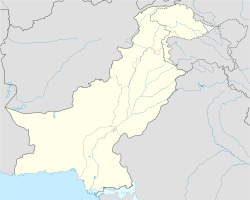
Back Multan Afrikaans ملتان Arabic ملتان ARZ मुल्तान AWA Multan Azerbaijani مولتان AZB Мултан Byelorussian Мултан Bulgarian মুলতান Bengali/Bangla Multan Catalan
Multan
ملتان | |
|---|---|
Al Mustafa Mosque Shrine of Shah Rukn-e-Alam Qasim Gate Ghanta Ghar Chowk River Chenab Multan Cricket Stadium | |
| Coordinates: 30°11′52″N 71°28′11″E / 30.19778°N 71.46972°E | |
| Country | |
| Province | |
| Division | Multan |
| District | Multan |
| Autonomous towns | 6 |
| Union council | 4 |
| Settled | 3000 BC[1] |
| Government | |
| • Type | Metropolitan Corporation[2] |
| • Mayor | None (Vacant)[3] |
| • Deputy Mayor | None (Vacant)[3] |
| Area | |
| • Metro | 560 km2 (220 sq mi) |
| Population (2023[6]) | |
• City | 2,169,915 |
| • Density | 7,000/km2 (20,000/sq mi) |
| Area code | 061 |
| Website | multan |
Multan (ملتان; local pronunciation: [mɵlˈtäːnᵊ] ⓘ) is a city in Punjab, Pakistan, located on the bank of the river Chenab. It is among the five largest cities of Pakistan in 2025 and is also the administrative centre of Multan Division. It is a major cultural, religious and economic centre of the Punjab region. Located in central Pakistan, with a district population of 5.3 million, it is the main hub of Southern Punjab.[7]
The oldest name of the city “Mulasthan” is derived from the Sanskrit language. [8]
Multan is one of the oldest cities of Asia with a history that stretches deep into antiquity. Multan was part of the Achaemenid Empire of Iran in the early 6th century BC. The ancient city was besieged by Alexander the Great during Mallian Campaign. Later it was conquered by the Arab military commander Muhammad bin Qasim in 712 CE after the conquest of Sindh. In the 9th century it became a separate state, the Emirate of Multan including in its limits parts of Punjab and Kashmir, it was ruled by the Arab rulers. The region came under the rule of Ghaznavids and the Mamluk Sultanate in medieval period. In 1445, it became a separate Langah Sultanate. Multan province was one of the largest provinces of the Mughal Empire. The Sikhs ruled over Multan from 1801 till 1848 when it was conquered by the British and made part of British Punjab.[9][10]
The city was among the most important trading centres of South Asia with strong ties to Iran, Central Asia and the rest of the Persianate and Muslim world. It was a great centre of knowledge and learning in medieval South Asia during Turkish-Persian rule,[11] and attracted a multitude of Sufi mystics in the 11th and 12th centuries, becoming a great centre of spirituality in South Asia and earning the city the sobriquet "City of Saints." The city, along with the nearby city of Uch, is renowned for its large number of Sufi shrines dating from that era.[12]
- ^ Cite error: The named reference
multan1983was invoked but never defined (see the help page). - ^ "Every fourth district in Punjab to have a metropolitan corporation". 27 December 2019.
- ^ a b "Administrators' appointments planned as Punjab LG system dissolves today". The Nation (newspaper). 31 December 2021. Retrieved 5 January 2022.
- ^ "Punjab Portal". Archived from the original on 14 April 2006. Retrieved 17 September 2009.
- ^ Area reference Archived 14 April 2006 at the Wayback Machine, Density reference Archived 26 September 2009 at the Wayback Machine statpak.gov.pk
- ^ a b "TABLE 1 : AREA, POPULATION BY SEX, SEX RATIO, POPULATION DENSITY, URBAN POPULATION, HOUSEHOLD SIZE AND ANNUAL GROWTH RATE" (PDF). 2023. p. 6. Retrieved 9 January 2025.
- ^ "District Profile | Multan". multan.punjab.gov.pk. Archived from the original on 26 December 2024. Retrieved 2 February 2025.
- ^ "Multan through the ages". The Friday Times. 15 September 2017. Retrieved 9 April 2025.
- ^ "Our History | Multan". multan.punjab.gov.pk. Archived from the original on 2 December 2024. Retrieved 30 January 2025.
- ^ "Tareekh-e-Pakistan (Wasti Ahad)". Yahya Amjad. Retrieved 26 March 2025.
- ^ Cite error: The named reference
Leviwas invoked but never defined (see the help page). - ^ Khan, Ahmad Fraz (18 January 2021). "Multan's mangoes and multinationals". DAWN.COM. Retrieved 20 January 2021.







